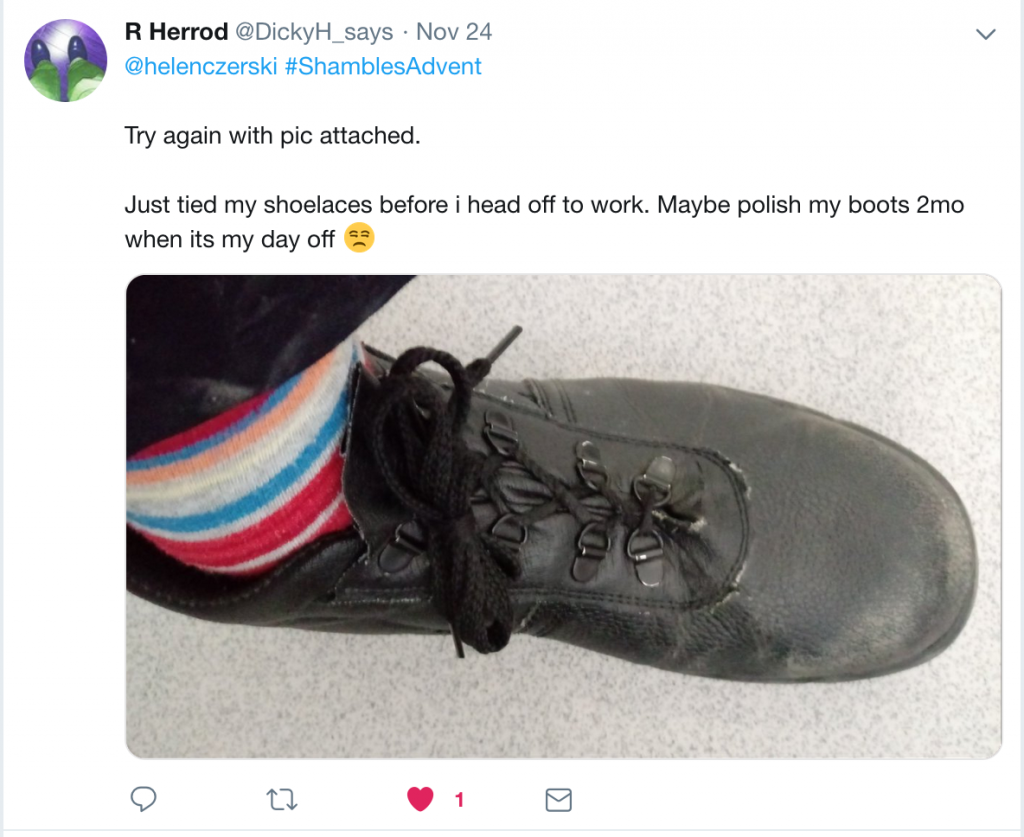Day 2 - Shambles Advent
Blog in a Teacup by Dr Helen CzerskiDay 2 – @DickyH_says
Every day until Christmas Dr Helen Czerski will be finding some cool, hidden science in pics of people’s every day lives. To get involved, tweet your pic to @helenczerski and @cosmicshambles with the hashtag #ShamblesAdvent

Today’s picture was sent by @DickyH_says. I’m a big fan of colourful socks (of colourful anything, in fact – beige would be banned if I had my way) so this photo made me smile even before I’d really looked carefully at it. But then what drew my attention was the laces.
I can’t tell from the photo, but let’s assume they’re made of cotton (the same principle applies for pretty much any fibre). The cotton strand that came off the plant will have been somewhere between 1cm and 6cm long, nowhere near long enough for a shoelace. And there’s no glue in there. What’s holding the shoelaces together?
Take a step back for a second and imagine wringing out a very wet towel. As you twist the towel, the bits of towel on the outside don’t get any longer, but the twisting forces them to wrap around the inner bits, and so they squeeze inwards. In the case of a towel, that squeezing pushes water out. But let’s go back to our shoelace. By spinning cotton fibres together, the manufacturers are twisting bundles of those fibres so that they’re squeezed together, bringing lots of strands into close contact. All those squeezed fibres have rough surfaces which are now interlocked on a tiny scale. If you try to pull the ends of your new cotton thread, the interlocked fibres can’t slide over each other. There’s a vast amount of friction keeping each one in position, and this is not a battle that you’re going to win. Friction holds each tiny fibre against the one next to it, which is held against the next one along, and we call that chain a thread. Then multiple threads are twisted again to make a bigger twisted structure, also held together by friction. And then that’s woven into a shoelace.
The shoelace works because it’s got a knot attaching the two ends together, maintaining the tension in the lace. And the knot only works because the laces are squeezed together and can’t slide over each other because of… friction. The same principle applies if you ever see a ship moored using giant ropes, which are just fibres spun into threads, spun into string, spun into rope, spun into bigger rope… and so on up the scale. The friction between tiny individual fibres can hold a 100,000 ton ship against a dock.
We think of friction as being an annoyance, something that makes life more difficult and gets in the way. But rope, knots, weaving, yarn, your woolly jumper and your laced-up shoes… all of these are held together by friction, and nothing else.
The Cosmic Shambles Network relies on your support on pledges via Patreon so we can continue to provide great, new, exciting content without the need for third party ads or paywalls.
For as little as $1 a month you can support what we do and get some great rewards for doing so as well. Click the Patreon logo to pledge or find out more.
 Dr Helen Czerski is a physicist, first and foremost, but she’s acquired a few other labels along the way: oceanographer, presenter, author and bubble enthusiast. A regular on The Cosmic Shambles Network, she has also presented a number of acclaimed documentaries for the BBC and her first book, Storm in a Teacup, which looked at the physics of every day things, was a bestseller. Recently she was awarded the prestigious William Thomson, Lord Kelvin Medal and Prize from the Institute of Physics.
Dr Helen Czerski is a physicist, first and foremost, but she’s acquired a few other labels along the way: oceanographer, presenter, author and bubble enthusiast. A regular on The Cosmic Shambles Network, she has also presented a number of acclaimed documentaries for the BBC and her first book, Storm in a Teacup, which looked at the physics of every day things, was a bestseller. Recently she was awarded the prestigious William Thomson, Lord Kelvin Medal and Prize from the Institute of Physics.
If you would like to reuse this content please contact us for details
Subscribe to The Cosmic Shambles Network Mailing list here.


